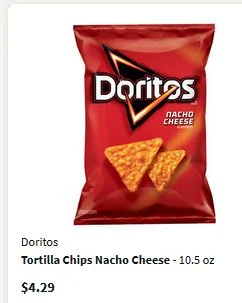"Farming is the only business where all inputs are purchased retail and all output is sold at wholesale" -Unknown
Q:"So, Zeb, whatchyer boy going to college for?"
A:"I am sending him to school to become a 'middle-man'."
At $6 a bushel, a $3.69, 20 oz loaf of whole-grain bread has approximately ten cents of wheat in it. That is roughly 6% of the cost of that loaf.
A $4.29 bag of Doritos has $0.035 of corn in it. that is about 0.8% or about 1 part in 125.
A $22 bottle of Tito's Handmade Vodka has $0.14 of corn in it. That is 0.6% or one part in 160.
The point is that prices farmers receive could quadruple (+300%) and the price of a loaf of bread would move up thirty cents or approximately +20%. That bag of Doritos would increase rise about 10 cents or by 2.5% and the bottle Tito's would rise by about half a dollar or by about 2%.
Carbon
Suppose you were the Ghorka Gola Corporate Food company and were interested in investing farmland in Outer Midwestlandia. That is brain-dead at today's prices BUT has potential if legislation shrinks the acres in production by reverting substantial portions of it back to prairie to sequester carbon.
That would shrink supply.
Then, if Congress were to suddenly discover ethanol as a "carbon neutral fuel", then that would sink over-supply.
Ghorka Gola can easily absorb the increased cost in raw materials because they are such an inconsequential part of the total cost of putting product on the shelf. The pretty bag costs more than the grain and the advertising costs more than the grain and the bag combined. In the over-all scheme of things the price of corn and wheat are "noise" and rising crop prices can even be used to justify increasing prices of the finished product.
From Ghorka Gola's standpoint, a two-step process would be most desirable. First, the old farmers who are holding out for $15k an acre die off and land floods the market, depressing prices.
Then GG buys the land just before Congress passes legislation "blessing" ethanol and carpet bombing the sunny west with incentives/subsidies to install solar and sequester carbon.
The small farmer will get elbowed away from the feed-trough as the Ghorka Golas of the world have full-time legal staff to fill out paperwork.


If you are drinking Titos Vodka, well then I just feel sorry for you. That crap is medicinal tasting swill.
ReplyDeleteI chose it because it is "neutral spirits" with almost no aging. It just happened to be the current best-selling single brand in the US.
DeleteI grew up on a hay farm. We did square bailing up until I went off to collage after 2 years at the community college. The profit margin was better with the square bales but I was the cheap labor. We had Coastal Bermuda which is an excellent hay for horses and we could charge the premium prices which was an all cash business. Roll hay went to dairies and they would get weekly deliveries and pay net 30. The bonus was we would also get raw milk and shoulders that were very wide supporting some large guns.
ReplyDeleteFrom March to October it was cutting the fields about every 28 days around the weekly deliveries. A cut would happen one day and the next morning after the dew had dried it was raked into wind rows, then bailed. The first cutting and last would be rolled and discounted as the quality was down. The second cutting would be square bailed for horse hay, we would put up 15K square bales that would max out our barns. The rest was rolled where they got stacked 3 high along the fence row and open air tarped just to keep the rain off.
Dairy deliveries would be loaded the night before. I could pull out as early as 3 AM to get to the dairy at 6. The dairy tractor or Bobcat would have me unloaded in 15 minutes and I could make my 10 am college classes. After classes it was cutting or moving bails.
Square bails were picked up with a 69 bail stacking machine. I called it the New Holland Monster. I could put 69 square bales in the barn every 11 minutes. Square bail delivery could be interesting. The Doctor's trophy wife was my my favorite delivery. She was mid thirty's and would watch me unload the pickup and stack the hay in her stable. She would always bring me an Arnold Palmer as a refreshment after stacking their 35 bales that they would go through monthly.
Six day weeks during bailing season. When things slowed down in October we were fishing at least one day per week or more until we started liming the pastures in February. The operation drew down a bit when I left for college. There was no room for me when I got back. I got married and the farm could not support two families.